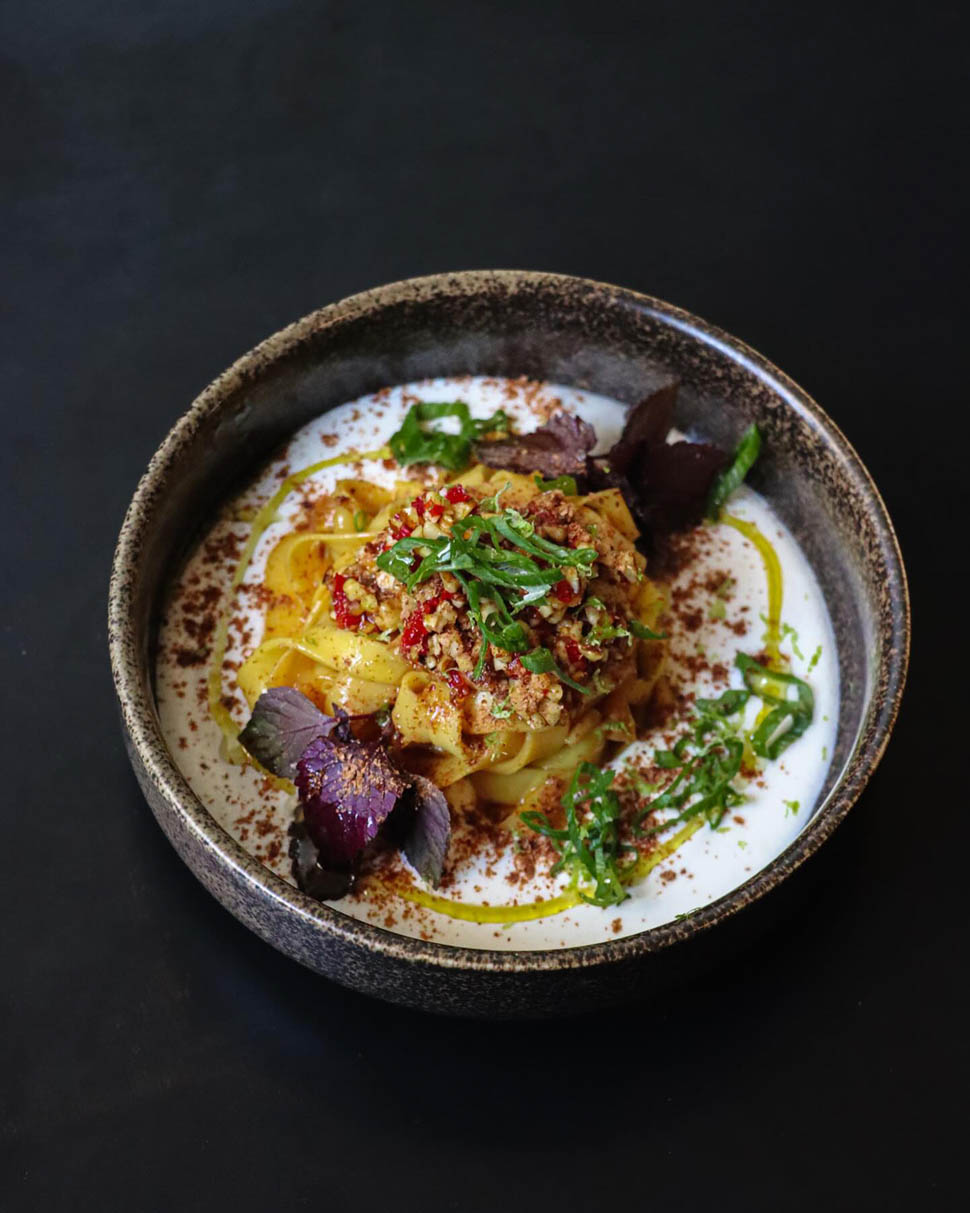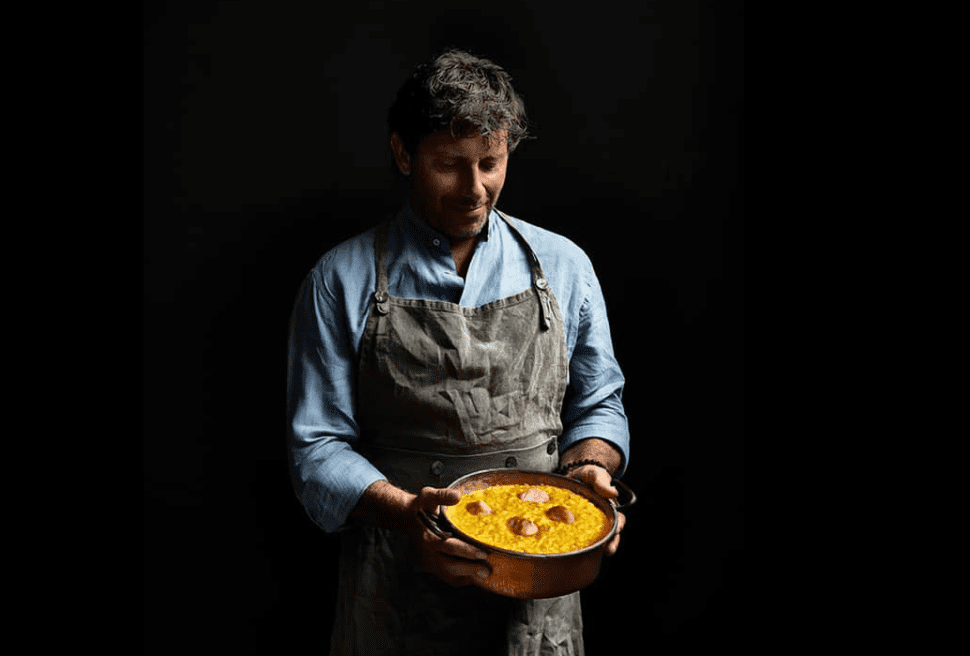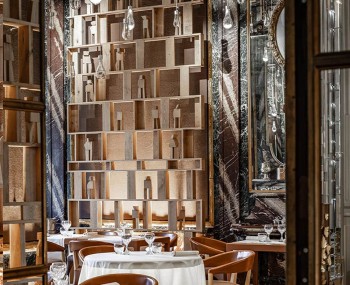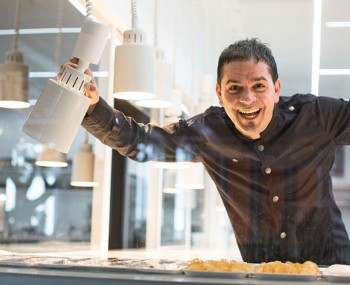“Every year we are version 2.0 of the previous season, you have to evolve but also stand firm on your identity.” Beyond the review, Cesare Battisti tells Reporter Gourmet about himself: a dialogue that lets the person emerge before the cook.
The restaurant
Although a great chef a few years ago disagreed with me, I still argue that cooking has many common elements with fashion. Both arts, both directed toward pleasure, and both litmus tests of society. Another element that makes me think that these two worlds travel together is the fact that fashions come back (sometimes inexplicably, since some things would be good to forget in the back of the trunk) and so do recipes, dishes, and ingredients.

Today, for example, at least in Milan, there is a strong desire to return to osterias. Those warm places with understandable cuisine and reasonable prices where you can spend your Sunday lunch. Dozens of such “little places” open every week in the city, but if it is true that we still have Giorgio Armani to thank for his unstructured jackets in his first collection in 1975, it is equally true that we should thank Cesare Battisti's Ratanà, forerunner of contemporary Milanese osterias.

Opened in 2009 by Cesare Battisti and Danilo Ingannamorte, Ratanà immediately broke the gap between the traditional trattoria and the starred restaurant, deconstructed the two concepts and reconstructed a new way of eating at the restaurant, that of the modern osteria.

Another matter that makes Ratanà unique is its location. The restaurant is in a historic building dating back to the 18th century, the structure is low in comparison to the futuristic-looking skyscrapers that surround it (we are in the Porta Nuova area), but it does not disfigure; in fact, it does the David and Goliath effect that helps the more romantic to hope for the best. The location, setting and interior, exactly reflect Ratanà's guiding values: tradition and future.

Another of the things worth popping in (or redoing) at Ratanà is sustainability. A used and abused term that has almost lost its meaning by now, but here it takes on a broader and more concrete meaning. In addition to the choice of ingredients and suppliers, which are most often small producers in the area just outside the Meneghina and are all listed on the menu, there is the human aspect of management and the well-being of its guests.

Let me give you a couple of examples. The kitchen team consists of a group of professionals who chose Ratanà as their place of work because it gives them the opportunity to express themselves with freedom and enthusiasm with a fair salary. And, again, since its inception Ratanà has been a forerunner in choosing to offer only freshwater fish and not seafood on its menus. This decision was made after extensive research that identified several small lake and river fishermen, as well as aquaculturists, who can regularly provide a product of the highest quality and with a strictly ethical approach to their work.

Ratanà's cuisine has always been inspired by the gastronomic traditions of Milan and Lombardy and has always been able to establish a dialogue between past and contemporary cuisine. Here flavors recall memories but lead to new textures and cooking techniques. The dishes are enjoyable and at the same time light, simple and complex. I don't think I need to add anything more, at this point I would give the floor to Cesare Battisti, with whom I had a long chat one afternoon while he was in the car with his children who had just been picked up from school.

Chef, we are seeing you quite a lot on TikTok with interesting and also very funny videos in which you prepare your dishes. How do you frame this social platform in the communication of historic kitchens like yours?
So, I'll tell you right away, I'm not someone who goes on social media to post, but thanks to the communication girls, who are very good, I understood a lot about this universe. Of course, all these socials kind of push us away a little bit, but they are also a way to make yourself known in a world of self-promotion. This seems to be working, and what I'd like to do is give voice and space to all my small suppliers and producers. I've also realized that what goes around every day on social media is a real job, made up of long times and a lot of energy spent. Otherwise I feel like a puppet of sorts (laughs, ed.).

How does the Ratanà of today compare with that of yesterday? Has there been any change or evolution?
It is a different restaurant. It is with each passing year because every year we are version 2.0 of the previous year thanks to a huge, and I emphasize huge, teamwork. Every year the dishes are revised, signature included. People's palates change, the bar is always higher. To think of having a restaurant the same over the years is almost madness. Cooking and dining have such moving languages that you can no longer be static, you either evolve or you involute.
From a gastronomic point of view, and not only that, how is Milan changing?
But do I have to tell the truth?
Yes.

Milan has always been a bit of a fashion victim, and the restaurant industry pays for this as well. It is changing in the same way that the whole contemporary society is changing i.e. everything is more superficial. Even the proposal is more superficial. Today you open restaurants and along the way you build the storytelling. It used to be different, first because we called storytelling an identity and then because the process was reversed. If there was an identity, something to say or an urgency to tell, then you opened a restaurant to transfer those messages. But it doesn't work that way, someone has to have the courage to say it, and you also have to be prepared not to please everyone to defend your identity. We live in such a beautiful country, so full of traditions and so rich in culinary identity, I embody one and try to make it more contemporary and suitable for the palates of people today. But I accept that not everyone likes me. Milan does not always accept not pleasing everyone. People's palates have changed, they are looking for sour...

(I interrupt him) Good thing, or else we'd still be here eating aspic.
That's right. When you have a restaurant like Ratanà and therefore you have tradition in your hand, you find that the public is divided into two. On one side are those who tell you that you are too traditional and on the other side are those who tell you that you are untraditional. I was taught that tradĕre, in Latin, means to pass on, to transmit. I try to carry on my cooking over time the best way I know how, but I can't please everyone. Good thing we don't do open-hearted operations. Ratanà's identity is to work with small producers who cultivate their little pieces of land, who raise trout, and who do things with love. We like to work with beautiful people. This is struggling to get through as news, but what are we to do? Patience. We try to maintain our identity.

Everyone talks about the high costs of this city that now seems almost impossible to live in. What is your position on this?
Milan is an expensive city. After Expo in 2015, it took off and was a candidate to become one of the European food capitals. Wages have not adjusted and we have lost purchasing power. I pay my guys well. I've done the math with the accountant, and in the last year the restaurant's food and wine costs have increased by 20 percent. I don't want to add more, I'm a cook and I want to talk about that.

It seems that one of the new trends for food lovers is a return to the trattoria/hosteria atmosphere but with a greater focus on the kind of cuisine of the 1990s? Do you agree with that? What do you think?
After the pandemic people are looking for substance. People want to recognize us in something. Maybe the era of white tablecloths and uniformed waiters will come back, it all comes back, but this is a time when people prefer a little more substance done right and without a lot of frills.


Maybe it's a bit of a reflection of what we were saying at the beginning on the topic of social media?
Exactly this stuff here, there is more of a desire for contact.
Can you recommend a good place to try in Milan? your plans don't apply.
I have a visceral love for Juan Lema and Trattoria Mirta, but also for Francesco Costanzo of Pastamadre. I like to go to people who give me something, not only in food. I also need human contact, the freedom of the innkeeper who sits at the table and tells about himself.

Contact
Ristorante Ratanà
Via G. de Castillia, 28 - 20124 Milan
Open every day for lunch and dinner
Reservations: +39 02 87128855
Email: info@ratana.it











